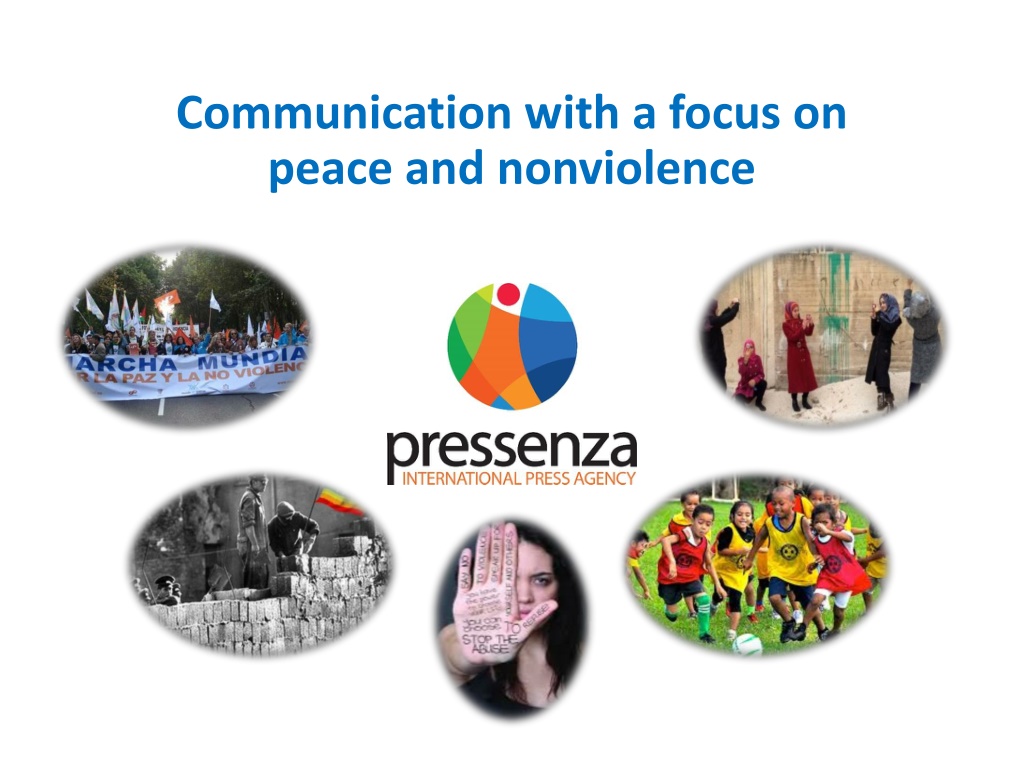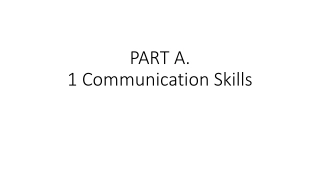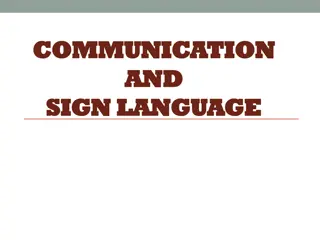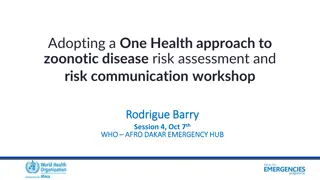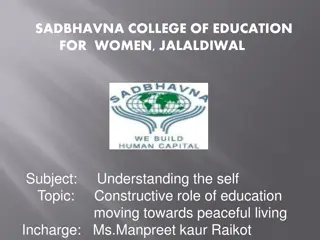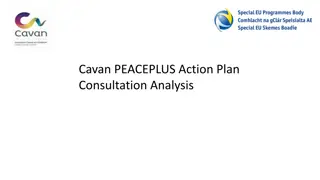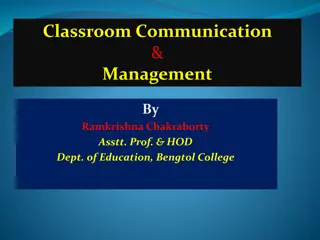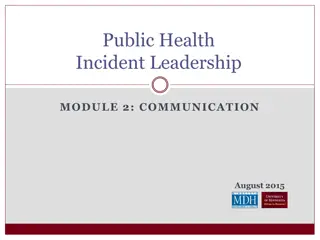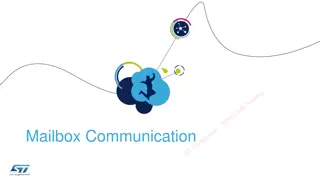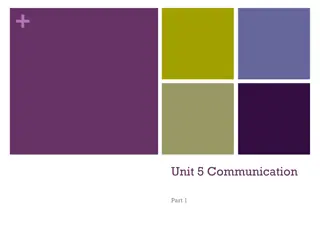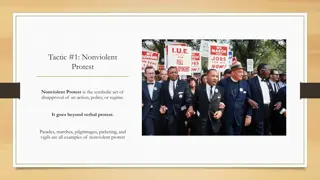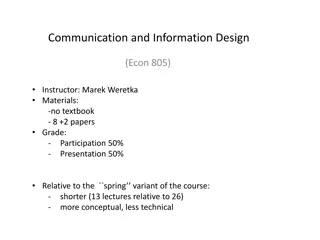Principles for Peaceful Communication
Principles for communication with a focus on peace and nonviolence. Explore the importance of truthful reporting, rejection of violence, embracing diversity, transparency in viewpoints, understanding human intentionality, fostering a new sensitive approach, and continuous knowledge development.
Download Presentation

Please find below an Image/Link to download the presentation.
The content on the website is provided AS IS for your information and personal use only. It may not be sold, licensed, or shared on other websites without obtaining consent from the author.If you encounter any issues during the download, it is possible that the publisher has removed the file from their server.
You are allowed to download the files provided on this website for personal or commercial use, subject to the condition that they are used lawfully. All files are the property of their respective owners.
The content on the website is provided AS IS for your information and personal use only. It may not be sold, licensed, or shared on other websites without obtaining consent from the author.
E N D
Presentation Transcript
Communication with a focus on peace and nonviolence
PRINCIPLES PRINCIPLES for communication with a focus on for communication with a focus on Peace and Nonviolence Peace and Nonviolence
Principle 1 Information is a social commodity Therefore, reports can t be distorted and the information must be complete. It isn t right to present only one side of the coin, for example, the violent side be it intentionally or inadvertently.
Principle 2 Violence is unacceptable in all its forms Therefore, to endorse explicit or implicit violence, either through the use of words or pictures, is not ethical.
Principle 3 Diversity is richness Therefore, to push dissemination of the freedom of choice and thought; to promote a coming together and cultural convergence; to give space to the different expressions, are tasks that we should undertake.
Principle 4 The point of view from where one reports is always present. Therefore, it is essential to make it explicit so that our audience/readers clearly know what to expect from our articles.
Principle 5 Human intentionality is behind every action Therefore, it is down to us to show the intimate relationship that exists between the inner human world and the world around us. In this way, it is possible to show the intentions present in human actions and to humanise our look over the events and people that produce them.
Principle 6 A new sensibility is starting to appear Therefore, we are opening channels for joy, softness, compassion, inspiration, creativity and working together, in order to replace communication paradigms that tend towards what is frightening, simple entertainment, violence and the elevation of individualistic values.
Principle 7 Knowledge is in permanent development Therefore, to contribute to the growth of this knowledge of events through contextualisation in space and time is also our task.
Principle 8 We don t just provide information Therefore, we are directly committed to the struggles that have human beings as their central concern; we get involved with them. In this way, we overcome our own violence and we inspire a transforming attitude.
Principle 9 Nonviolent conflict resolution is a priority Therefore, we encourage dialogue and reconciliation, we prefer a coming together over polarisation and we identify the competing interests in order to open possible channels for resolution.
Principle 10 Responsibility is not the same as guilt Therefore, we don t avoid criticism. In situations of violence, it is necessary to identify those responsible. We talk about responsibility and not guilt, because guilt calls for revenge, and revenge means violence.
Principle 11 There is systematic system of oppression Therefore, identifying how this structure operates on individuals allows us to explain the context for many phenomena, although this doesn t exempt people from the responsibility for their decisions.
Principle 12 The best possible information is in the grassroots Therefore, to provide a space for the expression of the people themselves, for the dissemination of their activities that come from the grassroots is our priority.
IN SUMMARY: IN SUMMARY: PRINCIPLES PRINCIPLES for communication for communication with with a focus on Peace and Nonviolence a focus on Peace and Nonviolence The point of view from where one reports is always present Violence is unacceptable in all its forms Information is a social commodity Diversity is richness Human We don t just provide information. Knowledge is in permanent development intentionality is behind every action A new sensibility is starting to appear Nonviolent conflict resolution is a priority Responsibility is not the same as guilt There is systematic system of oppression The best possible information is in the grassroots
TOOLS TOOLS for for communication communication with a on on Peace Peace and N and Nonviolence with a focus onviolence focus
Tool 1 Subject matter selection Open the agenda to issues that inspire positive changes or that show exemplary attitudes in society and in people, gathering the true stories of people and groups working locally for positive transformation. Report on every effort and advance made towards peace, humanism, nonviolence, human rights, disarmament and non- discrimination. Critically cover the multiple situations of violence. Avoid frightening rumours and create a climate of trust.
Tool 2 Information construction Promote the participation of several points of view and perspectives. Put the news in context and not publish it as an isolated event. Use multiple sources and voices. Make the view of the communicator explicit. Maximise the opinions of popular references (artists, scientists, sportsmen and women, political and religious leaders) as long as they lead to reflection and reconciliation. Facilitate the discussion between competing points of view in order to help the complementation of positions.
Tool 3 Language and meanings Include in the story positive vocabulary such as dialogue, understanding, communication, etc. Expose/de-naturalise/argue against commonly accepted meanings or phrases. Do not degrade any individual or people with the language used.
Tool 4 Communicational tone Use humour, irony and wit as resources to expose violence and to call for its surpassing. Appeal to creativity, joy and the poetic to open the future.
Tool 5 Analytical discourse Provide historical context and show the variations that there have been, demonstrating that the apparent permanence of points of view are, in fact, relative. Go beyond the logic of different factions and show that that there are many more points of view than those competing. Show the underlying competing interests. Look at the possibility that everyone is responsible and that everyone can act and collaborate. Avoid always blaming others for everything that happens.
Tool 6 Preparation of conclusions Profound positive models. Show the existing humanising models, that perhaps are unknown or have been buried for some reason, in the culture of the place,. Denaturalise fixed beliefs. Discuss negative or distorted beliefs such as human beings have a violent nature or that s the way things are . Not everything is black and white. Show the existing paradoxes in a single situation: interesting tendencies coexist even in the worst situations. The future is not the same as the past. Highlight the point of view of the future, which is not necessarily a repetition or automatic consequence of the past. Go beyond apparent determinism. Multiple paths and the possibility of an evolutionary and encouraging outcome. Affirm the existence of many alternatives and the possibility of an outcome that feeds hope.
IN SUMMARY: IN SUMMARY: Tools for communication with a focus Tools for communication with a focus on Peace and Nonviolence on Peace and Nonviolence Subject matter selection Information construction Preparation of conclusions Analytical discourse Language and meanings Communicational tone
